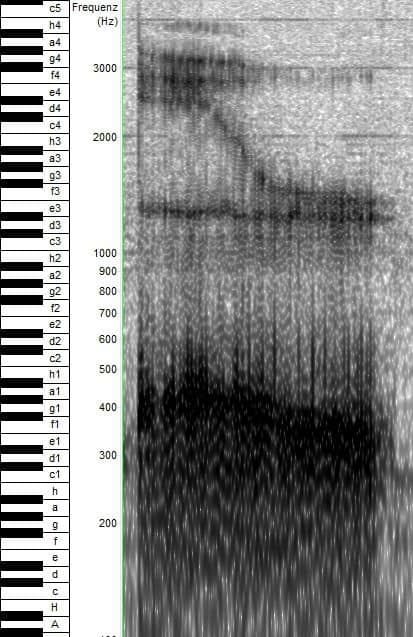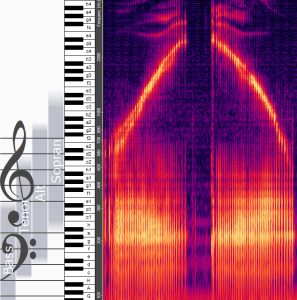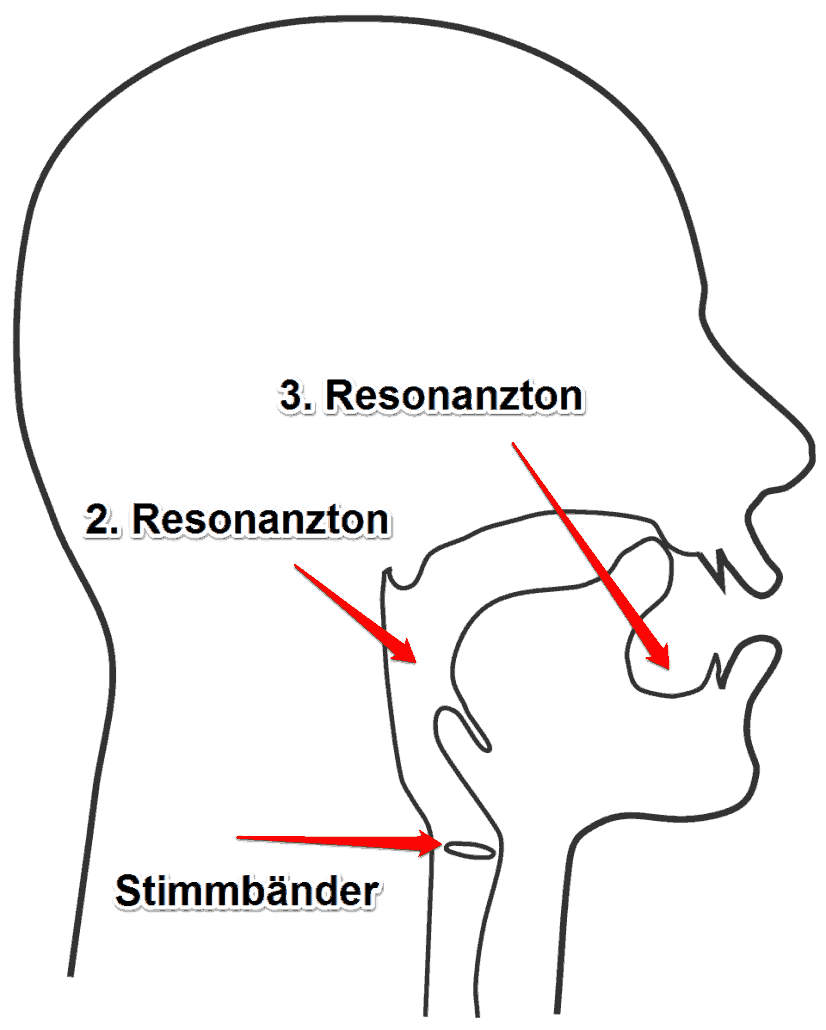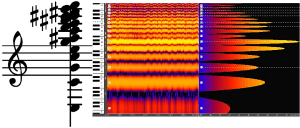What is Overtone Singing?
The art of singing two notes at the same time
Overtone singing is a vocal technique that creates the auditory impression of polyphony by filtering individual overtones from the sound spectrum of the voice by controlling the resonances in the vocal tract in such a way that they are perceived as separate tones. [(Saus 2004)]
Sound sample: Pianoo – Harmoniversum
Short Version
It is amazing when a single person sings two notes at the same time. A second flute-like tone suddenly sounds about two octaves above the normal voice, which seems to float crystal clear and hardly locatable in space. The sound is reminiscent of a glass harp, exotic and yet strangely familiar. It touches in a peculiar way, has a calming effect and is almost physically palpable.
Can anyone do that?
Yes, anyone who can speak can learn overtone singing.
How does overtone singing sound?
Brahms’ Lullaby in bass and soprano at the same time.
Where does overtone singing come from?
The styles were created independently of each other. Western overtone singing comes from Europe and not from Mongolia, as is often claimed. Altai styles of the Turkic peoples are related to each other. Less well known are overtone songs from Africa, Papua New Guinea and Tibet. Here is a list of styles:
How does overtone singing work?
The resonance in the mouth and throat are combined with tongue, lip and jaw movements in such a way that individual overtones become so loud that they are perceived as individual tones.
→ see below
The Trick: Double Resonance
The secret of overtone singing is double resonance – the merging of two resonance frequencies that originate in the pharynx and oral cavity (vocal tract) [(Kob, Neuschaefer-Rube, and Saus 2001), (Matern et al. 2001),
(Neuschaefer-Rube et al. 2002), (Saus 2009)]. This does not occur in the German language. That’s why overtone singing is not so easy to discover by oneself, although in principle it consists only of exotic “vowels”.
The lowest three resonance frequencies in the vocal tract can be changed in pitch arbitrarily. This is done with mouth-, lip-, tongue- and larynx movements. Vowels are created by the first two resonance frequencies, a special pitch for each vowel.
In overtone singing, the third resonance frequency is added and lowered to the pitch of the second resonance frequency by creating an additional cavity under the tongue.

The resulting double resonator is then precisely matched to an overtone [(Saus 2009)]. The effect: the overtone becomes much louder than its neighbours, which gives the impression that you hear two tones, namely the voice and the amplified overtone. If you move the double resonator from overtone to overtone, you get the impression of an overtone melody.
Overtone singers thus produce the melody with the form of the vocal tract, not with the vocal chords. The second resonance frequency determines the pitch. The third resonance frequency is used for amplification.
Actually, you still hear all the partials, not two. But the timbre created by the isolated overtone is so unfamiliar that the brain searches for a comparison with what it knows and thus communicates a flute-like sound and a singing voice to the consciousness. Overtone singing is thus a kind of acoustic illusion.
In fact, everyone hears the overtone singing a little differently. Some people experience more or less vowel character and associate the sound of the Australian didgeridoos. Others hear the sound of the flute so clearly and separately that they cannot believe it comes from the voice. These different perceptions are related to the individual sound processing (cf. How overtones work in the brain).
This double resonator can be varied over more than one octave. Most overtone singers don’t know anything about it. They are still good at overtone singing because they have intuitively learned over a long time to control their resonances. Those who have knowledge of the connections, however, learn overtone singing much faster and can optimize overtone singing in a targeted way. If you are looking for an overtone singing teacher, make sure he has this background knowledge. This saves time and money.

Voice as a Double Instrument
Our voice consists of two instruments:
- The primary sound (singing tone) is formed in the larynx and consists of a chord of partial tones (sine tones) and a noise portion. It generates the keynote pitch.
- The resonances in the vocal tract (mouth, throat, nose) modulate the volume of the partials. They produce the timbre. During overtone singing, they produce the melody from overtones.
Voice = primary sound + resonance
This corresponds to the classic source filter model of the voice. The new thing, however, is that in overtone singing the resonances are used as a second melody instrument. The fact that resonances can be tuned to a precise pitch is generally unknown and is not taught in classical singing education.
First Instrument: Harmonics
Overtones are a natural part of the voice. They are always present in the voice. A normal vocal sound consists of a bundle of partials (on the difference between partial and overtone, see here).
This bundle forms a special harmonic partial-tone chord, which we normally hear as a single note with a timbre. The timbre is created by the volume distribution of the partials. The volume distribution in the picture results from the vowel æ.
If an overtone becomes much louder than its neighbours, it will suddenly be perceived as a separate tone. This is exactly what happens with overtone singing. Extreme “vowels” are used, which are not found in the language. Overtone singing is in a way an acoustic illusion, because in fact only one note is sung, but because of an extreme “pronunciation” it sounds like two notes. But one could also say that it is an acoustic disillusionment: the tone consists of many tones, and now we hear at least two of them, the keynote and the amplified overtone.
Second Instrument: Resonance Frequencies
The mouth and throat space from the larynx to the lips is also called vocal tract. Like any cavity, the vocal tract has natural resonance frequencies. These resonances are pitches that change with the shape of the mouth. The resonances change the volume distribution of the partials in the voice. This creates vowels. The fact that the resonances can be used as a melody instrument, however, is completely unknown as a concept.
Pharynx Tongue & Second Formant

The pharynx tongue controls the 2nd resonance frequency (2nd formant), the space under the tongue controls the 3rd resonance frequency. The aim of overtone singing is to place the two resonances exactly on top of each other and to meet an overtone at the same time.
During examinations at the University Hospital Aachen we found that the pharyngeal tongue movement together with the epiglottis mainly controls the overtones .
Try it: Let your tongue hang out of your mouth and speak the English we with a creaking voice (vocal fry) and motionless lips, preferably in slow motion. And then the English you, which is the backwards movement. The vowel transition i-u and u-i in these words is now produced exclusively by the pharyngeal tongue because of the inactive front tongue. It’s important that you take time for all the intermediate vocals.
Usa a sound analysis program like Overtone Analyzer to record a spectrogram of the produced sound. You will see in the spectrogram that only the second resonance frequency moves.
Mouth Floor & Third Formant
We don’t move the 3rd resonance frequency in German vowels. Therefore, the associated tongue movements are unfamiliar. If you keep your tongue in the L-position, a cavity will form under your tongue. If you then lower the floor of your mouth and pull back the muscles at the side next to the frenulum of your tongue, you will hear a sound similar to the American “r” [ ɹ ]. Imagine a small hot potato under your tongue. The larger the cavity, the lower the 3rd resonance frequency.
With a little practice the 3rd resonance frequency can be lowered exactly to the frequency of the 2nd. That’s the basic technique of overtone singing.
Literature & Sources
Itemisations
Books
Specialist Articles
Websites
The first version of this article was published in 2000, the first WordPressverion on 8/3/2013.



I am thankful that this post shared that when considering a vocalist production house, it is important for us to be aware of their system and practice. It makes sense for us to do so as surely we want someone skilled and experience to help us with our vocals. Assuming I am looking for a studio, I will keep this tip in mind.
Ganz herzlichen Dank für diese klare, hervorragend strukturierte und überzeugende Darstellung!
Dadurch wird mir die Hörbarkeit des 2. Tons endlich deutlich.
Ich werde weiter daran versuchen.
so spannend
oberton.org war und ist aus meiner Sicht eindeutig die informativste Webseite zum Thema Obertongesang im deutschsprachigen Raum. DANKE für soviel Informationen und das ganze Engagement und die Zeit, die es erfordert, dieses ständig aktualisierte, wachsende und mittlerweile sogar interaktive lexikonartige Wissen hier zu versammeln und der Öffentlichkeit zugänglich zu machen. Ich bin echt begeistert von dieser Fundgrube für Stimm-Interessierte und Oberton-Fans!!!